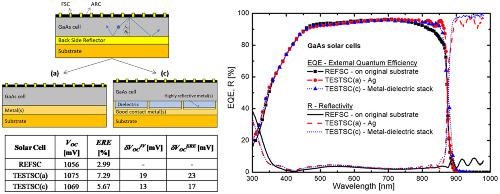当前位置:
X-MOL 学术
›
Prog. Photovoltaics
›
论文详情
Our official English website, www.x-mol.net, welcomes your
feedback! (Note: you will need to create a separate account there.)
Development of back side technology for light trapping and photon recycling in GaAs solar cells
Progress in Photovoltaics ( IF 8.0 ) Pub Date : 2018-10-12 , DOI: 10.1002/pip.3076 Daniel Neves Micha 1, 2 , Oliver Höhn 1 , Eduard Oliva 1 , Vera Klinger 1 , Andreas W. Bett 1 , Frank Dimroth 1
Progress in Photovoltaics ( IF 8.0 ) Pub Date : 2018-10-12 , DOI: 10.1002/pip.3076 Daniel Neves Micha 1, 2 , Oliver Höhn 1 , Eduard Oliva 1 , Vera Klinger 1 , Andreas W. Bett 1 , Frank Dimroth 1
Affiliation

|
In this work, we propose and realize three different design strategies to implement an optical cavity in GaAs thin film solar cells in order to confine its internal luminescence and hence to exploit photon recycling. The strategies are based on the definition of a highly reflective and very conductive back side, whereas front side light extraction is limited by total internal reflection. We show characterization results on the internal reflectivity of the back reflector and on the contact resistance at the rear side, important quantities for a good functioning of the final solar cell. First, a back side using only metal was optimized with a pure Ag layer leading to an internal reflectivity of 95.2% and a contact resistance of 1.0 × 10−4 Ω for a 1 cm2 device. With a metal‐dielectric stack at the back side and electrical contacts made by metals via point‐contacts, a second approach led to averaged internal reflectivity of 98.0% and contact resistance of 1.8 × 10−4 Ω for a 1 cm2 device. A third strategy in which a transparent conductive oxide in combination with a metal layer was used did not show the expected results in optical and electrical properties. We fabricated and characterized solar cells with the most promising back sides. When comparing with an ordinary reference GaAs solar cell, external radiative efficiency increased by factors of 150% and 90% for the thin film solar cells with pure Ag and with the metal‐dielectric stack at the back side, allowing enhancements of 19 and 13 mV in VOC, respectively.
中文翻译:

GaAs太阳能电池中用于光捕获和光子回收的背面技术的发展
在这项工作中,我们提出并实现了三种不同的设计策略,以在GaAs薄膜太阳能电池中实现光腔,以限制其内部发光并从而利用光子循环利用。这些策略基于高反射性和高导电性背面的定义,而正面光提取受到全内反射的限制。我们在背面反射器的内部反射率和背面的接触电阻(这对于最终太阳能电池的良好功能很重要的数量)上显示了表征结果。首先,使用纯银层对仅使用金属的背面进行了优化,导致 1 cm 2的内部反射率达到95.2%,接触电阻为1.0×10 -4Ω设备。第二种方法是在背面使用金属电介质堆栈,并通过点接触由金属制成的电触点,第二种方法导致 1 cm 2器件的平均内部反射率达到98.0%,接触电阻为1.8×10 -4Ω。使用透明导电氧化物与金属层结合的第三种策略没有显示出预期的光学和电学性能。我们制造并表征了具有最有希望的背面的太阳能电池。与普通的参比砷化镓太阳能电池相比,纯银薄膜太阳能电池的外部辐射效率提高了150%和90%,背面是金属电介质堆叠,可提高19 mV和13 mV在V OC中, 分别。
更新日期:2018-10-12
中文翻译:

GaAs太阳能电池中用于光捕获和光子回收的背面技术的发展
在这项工作中,我们提出并实现了三种不同的设计策略,以在GaAs薄膜太阳能电池中实现光腔,以限制其内部发光并从而利用光子循环利用。这些策略基于高反射性和高导电性背面的定义,而正面光提取受到全内反射的限制。我们在背面反射器的内部反射率和背面的接触电阻(这对于最终太阳能电池的良好功能很重要的数量)上显示了表征结果。首先,使用纯银层对仅使用金属的背面进行了优化,导致 1 cm 2的内部反射率达到95.2%,接触电阻为1.0×10 -4Ω设备。第二种方法是在背面使用金属电介质堆栈,并通过点接触由金属制成的电触点,第二种方法导致 1 cm 2器件的平均内部反射率达到98.0%,接触电阻为1.8×10 -4Ω。使用透明导电氧化物与金属层结合的第三种策略没有显示出预期的光学和电学性能。我们制造并表征了具有最有希望的背面的太阳能电池。与普通的参比砷化镓太阳能电池相比,纯银薄膜太阳能电池的外部辐射效率提高了150%和90%,背面是金属电介质堆叠,可提高19 mV和13 mV在V OC中, 分别。











































 京公网安备 11010802027423号
京公网安备 11010802027423号